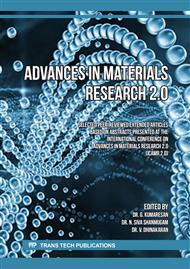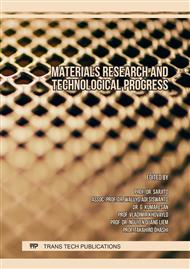[1]
S. Sun, M. Brandt, S. Palanisamy, and M. S. Dargusch, Effect of cryogenic compressed air on the evolution of cutting force and tool wear during machining of Ti–6Al–4V alloy,, J. Mater. Process. Technol., vol. 221, p.243–254, (2015).
DOI: 10.1016/j.jmatprotec.2015.02.017
Google Scholar
[2]
S. Sun, M. Brandt, and J. P. T. Mo, Evolution of tool wear and its effect on cutting forces during dry machining of Ti-6Al-4V alloy,, Proc. Inst. Mech. Eng. Part B J. Eng. Manuf., vol. 228, no. 2, p.191–202, (2014).
DOI: 10.1177/0954405413500243
Google Scholar
[3]
S. Sun, M. Brandt, and M. S. Dargusch, Effect of tool wear on chip formation during dry machining of Ti-6Al-4V alloy, part 1: effect of gradual tool wear evolution,, Proc. Inst. Mech. Eng. Part B J. Eng. Manuf., vol. 231, no. 9, p.1559–1574, (2017).
DOI: 10.1177/0954405415599956
Google Scholar
[4]
Z. Q. Liu, X. J. Cai, M. Chen, and Q. L. An, Investigation of cutting force and temperature of end-milling Ti–6Al–4V with different minimum quantity lubrication (MQL) parameters,, Proc. Inst. Mech. Eng. Part B J. Eng. Manuf., vol. 225, no. 8, p.1273–1279, (2011).
DOI: 10.1177/2041297510393793
Google Scholar
[5]
E. A. Rahim and H. Sasahara, Investigation of tool wear and surface integrity on MQL machining of Ti-6AL-4V using biodegradable oil,, Proc. Inst. Mech. Eng. Part B J. Eng. Manuf., vol. 225, no. 9, p.1505–1511, (2011).
DOI: 10.1177/0954405411402554
Google Scholar
[6]
A. Shokrani, V. Dhokia, and S. T. Newman, Comparative investigation on using cryogenic machining in CNC milling of Ti-6Al-4V titanium alloy,, Mach. Sci. Technol., vol. 20, no. 3, p.475–494, (2016).
DOI: 10.1080/10910344.2016.1191953
Google Scholar
[7]
S. M. Yuan, L. T. Yan, W. D. Liu, and Q. Liu, Effects of cooling air temperature on cryogenic machining of Ti–6Al–4V alloy,, J. Mater. Process. Technol., vol. 211, no. 3, p.356–362, (2011).
DOI: 10.1016/j.jmatprotec.2010.10.009
Google Scholar
[8]
M. A. Raja et al., Parametric investigation and optimization of AWJM process on stir cast al7075/basalt composite materials using Taguchi based grey relational analysis,, Mater. Today Proc., (2021).
DOI: 10.1016/j.matpr.2021.09.398
Google Scholar
[9]
X. Wu, L. Li, M. Zhao, and N. He, Experimental investigation of specific cutting energy and surface quality based on negative effective rake angle in micro turning,, Int. J. Adv. Manuf. Technol., vol. 82, no. 9–12, p.1941–1947, (2016).
DOI: 10.1007/s00170-015-7548-6
Google Scholar
[10]
S. Gao et al., Research on specific cutting energy and parameter optimization in micro-milling of heat-resistant stainless steel,, Int. J. Adv. Manuf. Technol., vol. 89, no. 1–4, p.191–205, (2017).
DOI: 10.1007/s00170-016-9062-x
Google Scholar
[11]
S. Debnath, M. M. Reddy, and Q. S. Yi, Environmental friendly cutting fluids and cooling techniques in machining: a review,, J. Clean. Prod., vol. 83, p.33–47, (2014).
DOI: 10.1016/j.jclepro.2014.07.071
Google Scholar
[12]
A. Shokrani, V. Dhokia, and S. T. Newman, Environmentally conscious machining of difficult-to-machine materials with regard to cutting fluids,, Int. J. Mach. Tools Manuf., vol. 57, p.83–101, (2012).
DOI: 10.1016/j.ijmachtools.2012.02.002
Google Scholar
[13]
S. Ghosh and P. V. Rao, Application of sustainable techniques in metal cutting for enhanced machinability: a review,, J. Clean. Prod., vol. 100, p.17–34, (2015).
Google Scholar
[14]
K. A. Al-Ghamdi, A. Iqbal, and G. Hussain, Machinability comparison of AISI 4340 and Ti-6Al-4V under cryogenic and hybrid cooling environments: A knowledge engineering approach,, Proc. Inst. Mech. Eng. Part B J. Eng. Manuf., vol. 229, no. 12, p.2144–2164, (2015).
DOI: 10.1177/0954405414548496
Google Scholar
[15]
K. Gupta and R. F. Laubscher, Sustainable machining of titanium alloys: a critical review,, Proc. Inst. Mech. Eng. Part B J. Eng. Manuf., vol. 231, no. 14, p.2543–2560, (2017).
Google Scholar
[16]
D. Setti, N. K. Yadav, and S. Ghosh, Grindability improvement of Ti-6Al-4V using cryogenic cooling,, Proc. Inst. Mech. Eng. Part B J. Eng. Manuf., vol. 228, no. 9, p.1131–1137, (2014).
DOI: 10.1177/0954405414534660
Google Scholar
[17]
A. Shokrani, V. Dhokia, and S. T. Newman, Energy conscious cryogenic machining of Ti-6Al-4V titanium alloy,, Proc. Inst. Mech. Eng. Part B J. Eng. Manuf., vol. 232, no. 10, p.1690–1706, (2018).
DOI: 10.1177/0954405416668923
Google Scholar
[18]
M. Mia, Multi-response optimization of end milling parameters under through-tool cryogenic cooling condition,, Measurement, vol. 111, p.134–145, (2017).
DOI: 10.1016/j.measurement.2017.07.033
Google Scholar
[19]
M. Mia, M. A. Khan, and N. R. Dhar, Study of surface roughness and cutting forces using ANN, RSM, and ANOVA in turning of Ti-6Al-4V under cryogenic jets applied at flank and rake faces of coated WC tool,, Int. J. Adv. Manuf. Technol., vol. 93, no. 1, p.975–991, (2017).
DOI: 10.1007/s00170-017-0566-9
Google Scholar
[20]
N. R. Dhar and M. Kamruzzaman, Cutting temperature, tool wear, surface roughness and dimensional deviation in turning AISI-4037 steel under cryogenic condition,, Int. J. Mach. tools Manuf., vol. 47, no. 5, p.754–759, (2007).
DOI: 10.1016/j.ijmachtools.2006.09.018
Google Scholar
[21]
F. Pusavec et al., Sustainable machining of high temperature Nickel alloy–Inconel 718: part 2–chip breakability and optimization,, J. Clean. Prod., vol. 87, p.941–952, (2015).
DOI: 10.1016/j.jclepro.2014.10.085
Google Scholar
[22]
M. Mia and N. R. Dhar, Response surface and neural network based predictive models of cutting temperature in hard turning,, J. Adv. Res., vol. 7, no. 6, p.1035–1044, (2016).
DOI: 10.1016/j.jare.2016.05.004
Google Scholar
[23]
S. Tirelli, E. Chiappini, M. Strano, M. Monno, and Q. Semeraro, Economical comparison of cryogenic vs. traditional turning of Ti-6Al-4V: A case study,, in Key Engineering Materials, 2015, vol. 651, p.1204–1210.
DOI: 10.4028/www.scientific.net/kem.651-653.1204
Google Scholar
[24]
S. Y. Hong and Y. Ding, Cooling approaches and cutting temperatures in cryogenic machining of Ti-6Al-4V,, Int. J. Mach. Tools Manuf., vol. 41, no. 10, p.1417–1437, (2001).
DOI: 10.1016/s0890-6955(01)00026-8
Google Scholar
[25]
M. K. Gupta and P. K. Sood, Machining comparison of aerospace materials considering minimum quantity cutting fluid: A clean and green approach,, Proc. Inst. Mech. Eng. Part C J. Mech. Eng. Sci., vol. 231, no. 8, p.1445–1464, (2017).
DOI: 10.1177/0954406216684158
Google Scholar
[26]
M. Mia and N. R. Dhar, Optimization of surface roughness and cutting temperature in high-pressure coolant-assisted hard turning using Taguchi method,, Int. J. Adv. Manuf. Technol., vol. 88, no. 1–4, p.739–753, (2017).
DOI: 10.1007/s00170-016-8810-2
Google Scholar
[27]
M. Mia, M. A. Khan, and N. R. Dhar, High-pressure coolant on flank and rake surfaces of tool in turning of Ti-6Al-4V: investigations on surface roughness and tool wear,, Int. J. Adv. Manuf. Technol., vol. 90, no. 5–8, p.1825–1834, (2017).
DOI: 10.1007/s00170-016-9512-5
Google Scholar
[28]
M. Mia et al., Effect of time-controlled MQL pulsing on surface roughness in hard turning by statistical analysis and artificial neural network,, Int. J. Adv. Manuf. Technol., vol. 91, no. 9, p.3211–3223, (2017).
DOI: 10.1007/s00170-016-9978-1
Google Scholar
[29]
M. Mia, M. Al Bashir, M. A. Khan, and N. R. Dhar, Optimization of MQL flow rate for minimum cutting force and surface roughness in end milling of hardened steel (HRC 40),, Int. J. Adv. Manuf. Technol., vol. 89, no. 1–4, p.675–690, (2017).
DOI: 10.1007/s00170-016-9080-8
Google Scholar
[30]
M. Al Bashir, M. Mia, and N. R. Dhar, Investigations on surface milling of hardened AISI 4140 steel with pulse jet MQL applicator,, J. Inst. Eng. Ser. C, vol. 99, no. 3, p.301–314, (2018).
DOI: 10.1007/s40032-016-0277-2
Google Scholar



